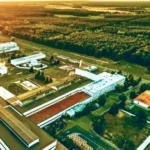If data is the 21st-century oil, then artificial intelligence is the new electricity. This statement, which is repeated more and more often, shows us that the digital transformation of various sectors of the economy is becoming necessary, and, furthermore, how far-reaching the consequences of the technological revolution can be. This also includes the Polish energy sector.Despite the growing interest in 4.0. Industry in Poland and the immense benefits to be gained from the digitalisation of the energy sector, we still remain only at the beginning of the digital road. The low level of digitalisation of Polish enterprises can be seen both in the Smart Industry report prepared by Siemens and the Ministry of Enterprise and Technology as well as inthe Digital Economy and Society Index of the European Commission. These reports show that the Polish private sector must accelerate its efforts to make enterprises take advantage of the commercial opportunities of digital technologies – writes Maciej Tomecki, a student at the University of Cambridge. His research focuses on the implications of the fourth technological revolution for energy policy.
This article has been published in the Polish Energy Brief quarterly.
Why do we need digitisation?
The digital energy transformation goals can be divided into business/short-term ones (direct increase in efficiency and savings resulting from process optimisation or elimination of waste through Industry 4.0 solutions) and long-term ones – changes in the entire energy system. Currently, the supply side of the energy sector in Poland is characterised by a high level of centralisation (electricity is generated in large power plants, transmitted through transmission and distribution networks and delivered to end users, whose role in energy consumption is mainly passive (Annunziata M. et al. 2016). On the other hand, a large part of electricity demand is inflexible in the short term (no change in energy consumption as a result of price changes). Digitalisation or Industry 4.0 solutions can change this balance (MIT, 2016).
In the coal industry, digital technologies are increasingly being used in geological modelling, process optimisation, automation, Predictive Maintenance (PdM) and to improve workplace protection and health. The IEA estimates that widespread use of digital technologies could reduce production costs by between 10 % and 20 %. In line withthe Polish economic strategy, the Intelligent Mining Programme is the programme meantto be responsible for the implementation of Industry 4.0 solutions in the mining sector, but it is only at a relatively early stage.
IEA estimates show that in the energy sector, digitisation can save around 5% of total annual generation costs. This can be achieved by reducing operating and maintenance costs, improving the efficiency of a power plant and network operations, reducing unplanned outages and extending the life of assets. One example is the use of drones to cheaply monitor thousands of kilometres of transmission lines across challenging areas.
Bringing Industry 4.0 into the energy sector allows for adjustment of demand to the needs of the whole system in real time, opening up the possibility for millions of consumers and producers to sell electricity or provide valuable services to the network (prosumers or DSR). The IEA estimates that digital demand-side solutions could provide 185 GW of global system flexibility – comparable to the combined installed capacity in Italy and Australia. The IEA estimates that this will save up to 270bn USD on investments in new electricity infrastructure. This conclusion may also illustrate the potential benefits for Poland from the digitalisation of the energy sector, which is currently transforming, not only in the low-emission direction but also in the technological direction.
Digitisation can also contribute to decarbonisation. It is indicated as a factor that can help to integrate unstable renewables by enabling the grid to better match energy demand when the sun is shining, and the wind is blowing. In the European Union alone, digitalisation can reduce carbon dioxide (CO2) emissions by about 30 million tons (Mt) in 2040 (these estimates do not apply to Poland, but they show the scale of benefits from digitalisation of the power industry).
Technological trends
The digitisation of energy is a component of a broader process of technological change which, together with changes in the regulatory and market landscape, is both a driver and a response to fundamental trends in electricity demand and supply. This is reflected in the cost reductions achieved over the last decade for several electricity technologies. For Industry 4.0, reducing the cost of several techniques is crucial to accelerate the digital transition:
IEA data shows that the unit cost of small photovoltaics has fallen fivefold since 2008, sensors by more than 95% and batteries by more than two thirds (mainly due to electric vehicles). The average cost of a smart meter has fallen by about a quarter, with nearly 600 million smart meters being deployed worldwide.
The four main elements of the power system transformation that digital technologies can enable or support are the following: (1) smart demand response; (2) integration of different renewable energy sources; (3) implementation of smart electric vehicle charging; and (4) emergence of small-scale, dispersed electricity resources such as domestic photovoltaic cells.

Industry 4.0 – Barriers
Timing: Investments in the energy sector are highly capital intensive (CAPEX and OPEX), and the implementation of large projects usually takes many years. Digital technologies, on the other hand, are evolving rapidly. Therefore, temporary rapid technological changes are not necessarily linked in time to the investment cycle in the energy sector. (IEA 2016).
Age of infrastructure: Many energy facilities were installed some time ago and did not necessarily have the infrastructure to enable new digital technologies. Upgrading these facilities would entail additional costs, making the use of digital technologies less attractive. As a result, digital technologies are more frequently used to increase security, reliability and reduce costs, i.e. short term objectives, but do not allow for a long-term quality change in the whole system.
Information Infrastructure (IT): Although many digital technologies are already available, many operators are unable to use them because their use requires a well-developed IT infrastructure and well-trained staff. (MIT 2016).
Conservative management culture: The capital-intensive nature of the energy industry and concern for system stability and energy security have shaped a relatively conservative management culture. Energy companies in Poland may expect service companies and external suppliers to develop digital technologies instead of bearing the risks and costs associated with large-scale internal R&D programmes.
Summary
The digitalisation of the energy sector is a global trend which is becoming more and more concrete and brings measurable results. Admittedly, currently in Poland we are only at the beginning of implementing solutions in the field of Industry 4.0, and the level of robotisation of the economy is one of the lowest in Europe, but such factors as, in particular, lowering the costs of digital technologies may significantly accelerate the digital transformation. An essential element of the implementation of Industry 4.0 in Poland is the establishment of the Polish Industry Platform 4.0, which is to be a national integrator of digital industrial transformation.
Implementation of Industry 4.0 will allow for the adjustment of demand to the needs of the whole system in real time, which will allow for a more active role of customers in the system. Industry 4.0 also stresses the crucial importance of energy networks. Industry networks 4.0 will enable stable integration, monitoring, aggregation and control of a large number of individual power generation and consumption units. These assets can be large or small, e.g. a photovoltaic system on the roof of a house, a boiler on an industrial site or an electric vehicle.
As digitisation progresses, a highly interconnected system can emerge, blurring the distinction between traditional suppliers and consumers, and increasing opportunities to increase local energy trade and network services.
Source: Polish Energy Brief








